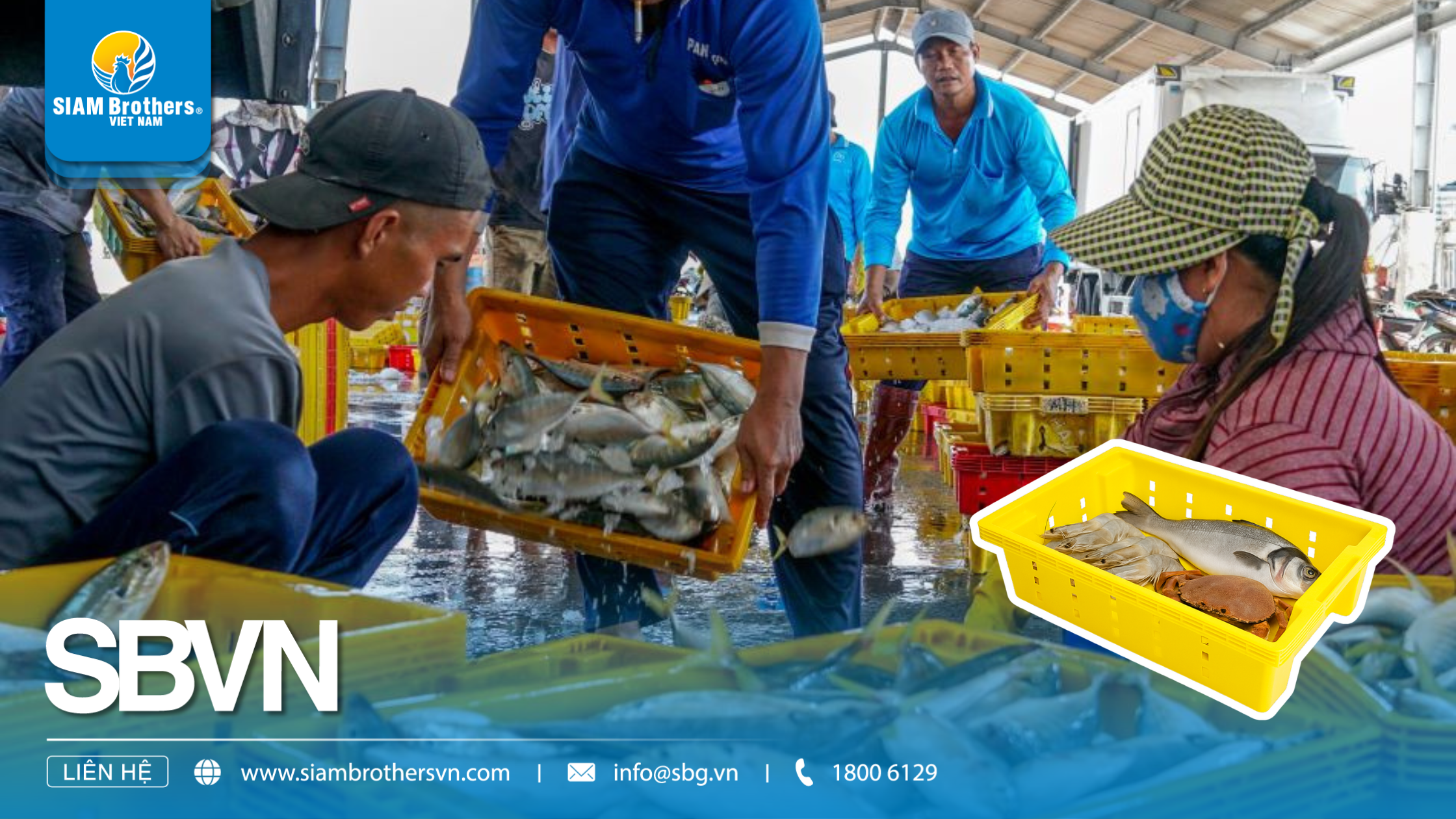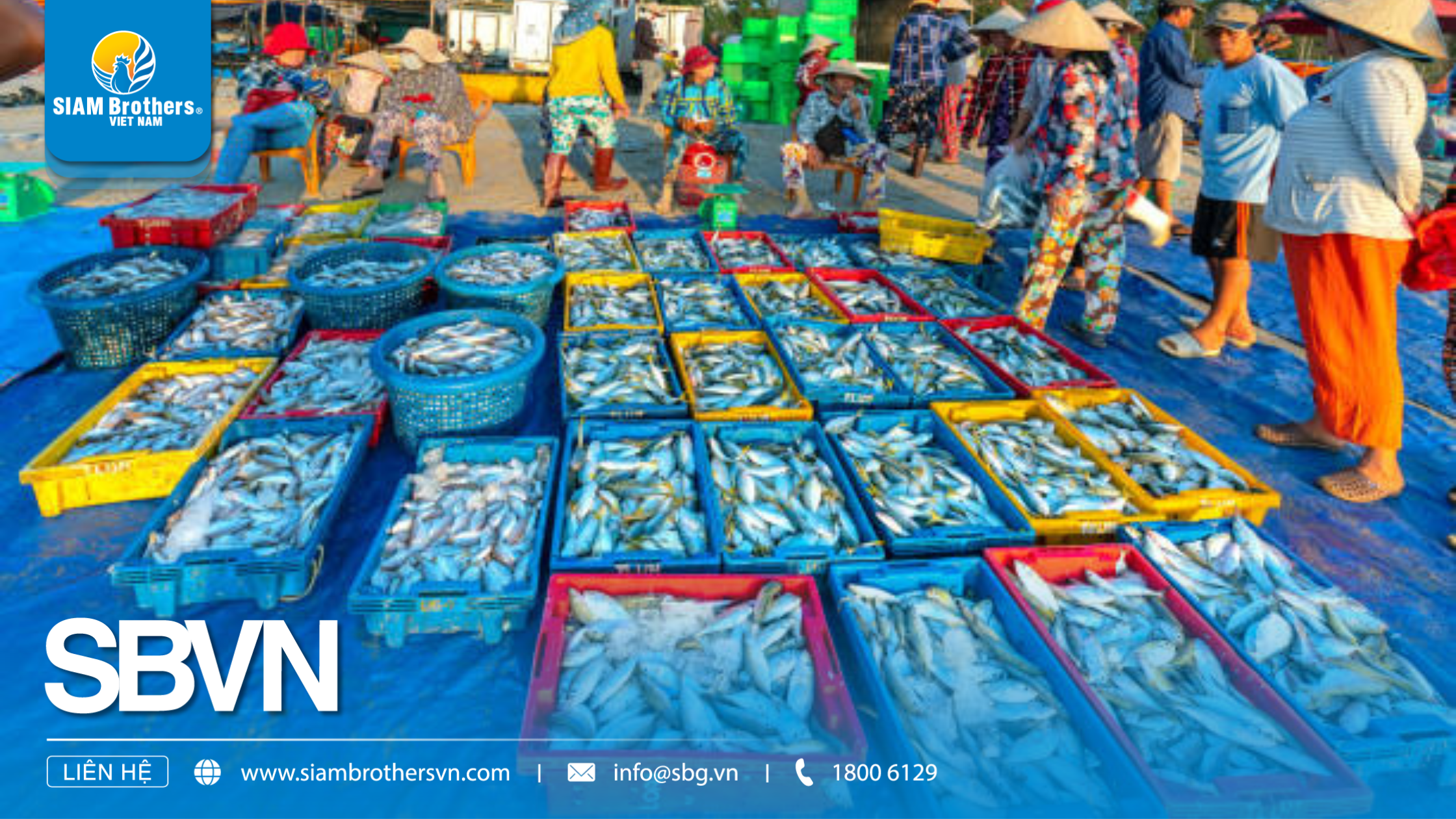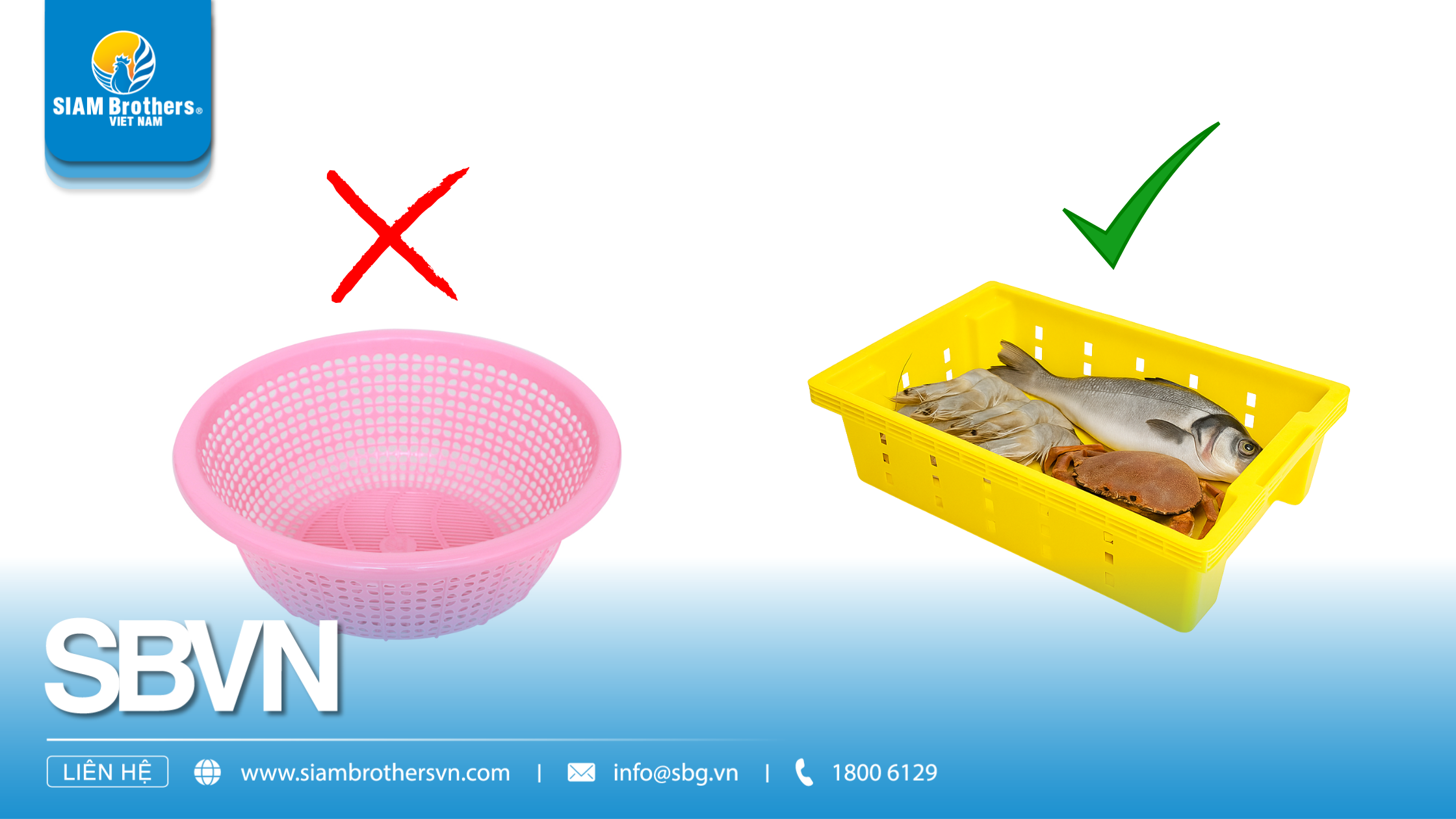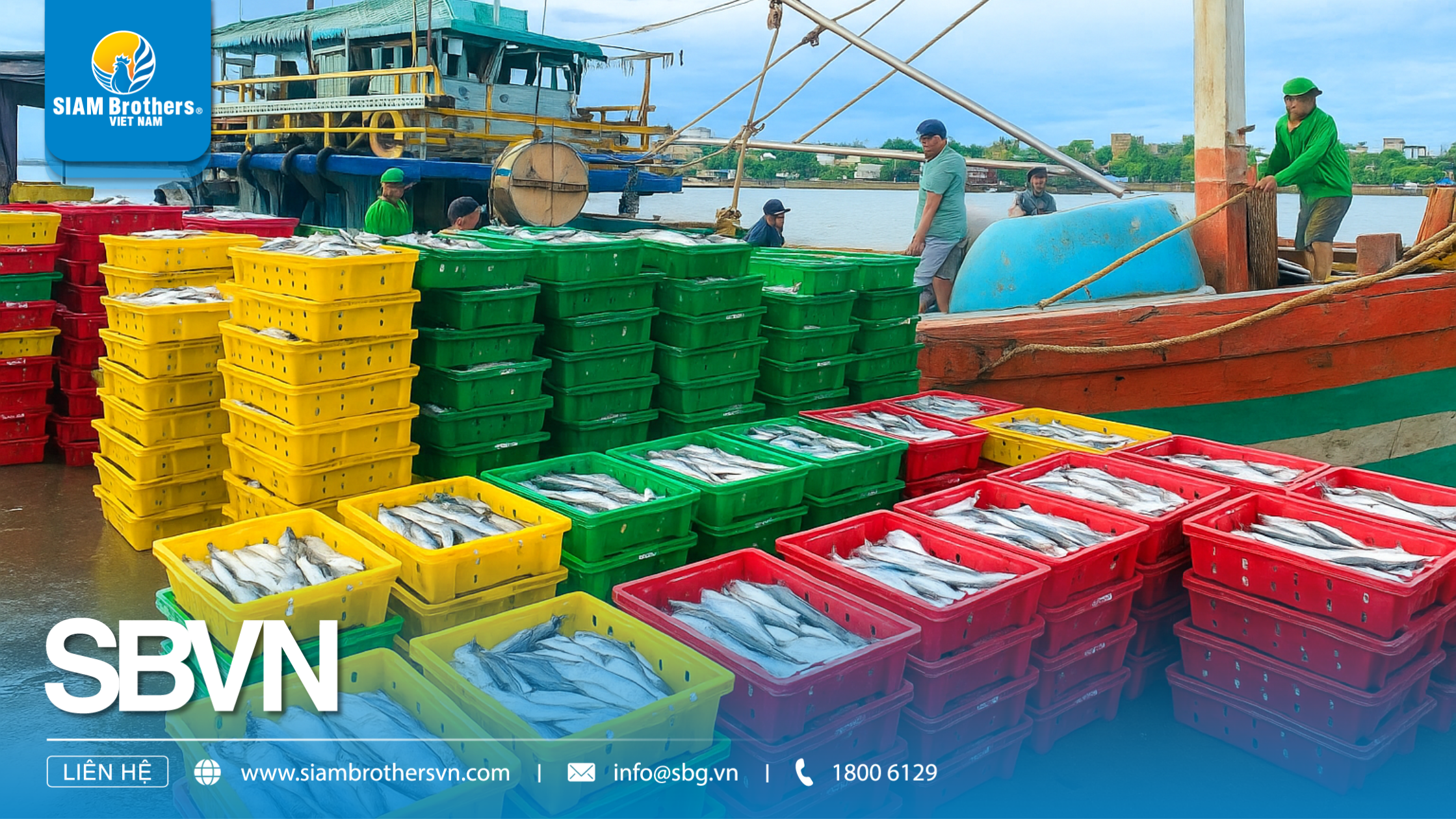A fish tray is a specialized plastic container widely used in the seafood industry to store, transport, and preserve fish effectively. But what makes more and more fishing boat owners, seafood processing facilities, and wholesale markets choose professional plastic fish trays over traditional sacks or baskets? In this article, SIAM Brothers Vietnam will walk you through the essential role of fish trays in the seafood supply chain — from the moment the fish are caught to when they reach the consumer.
1. What Is a Fish Tray?
A fish tray is a type of industrial-grade plastic tray specifically designed for containing, transporting, and storing seafood such as marine fish, shrimp, squid, and more. It is built to withstand the humid and harsh conditions of fishing, processing, and distribution environments.

Key Features of Fish Trays
- Durable plastic material: Fish trays are typically made from virgin HDPE or PP plastic — resistant to seawater corrosion, impact, and heavy loads.
- Optimized for stacking: The trays are designed with interlocking edges, allowing secure and stable stacking without crushing the fish inside.
- Optional drainage holes: Some models have perforated bottoms for fast drainage, preventing water buildup — ideal for storing fish with ice over extended periods.
- Various sizes and capacities: Depending on your needs, fish trays range from 10L to over 100L, suitable for both small fishing vessels and large-scale processing plants.
- Easy to clean and reusable: Fish trays offer a hygienic and cost-effective alternative to bamboo baskets or traditional sacks, with high reusability and low maintenance.
Why Are Fish Trays Becoming More Popular?
More than just a container, fish trays are becoming a new industry standard thanks to their multiple advantages throughout the seafood supply chain:
- Ensure food safety throughout handling, storage, and transportation.
- Optimize preservation: Maintain freshness longer through insulation and effective water drainage.
- Minimize operational risks: Prevent product spillage or damage during loading, unloading, and long-distance transport.
2. Practical Applications of Fish Trays in Fisheries
2.1 On Offshore Fishing Vessels
- Sorting fish on board: Fish trays allow crew members to classify seafood by size, type, or market value right after catching.
- Reduce product loss: Their sturdy design and stackable structure minimize bruising or crushing during onboard storage.
- Optimize storage space: Uniform tray sizes make it easier to organize cargo, saving room and streamlining inventory management at sea.
2.2 At Fishing Ports and Collection Areas
- Efficient offloading: With built-in handles or reinforced stacking rims, fish trays enable smooth transfer from boat to dock without spillage.
- Streamlined transfer to warehouses: Easier to track volume and quantity compared to baskets or sacks, reducing delays in the processing line.
- Limit contact with the ground: Enhances hygiene and minimizes contamination risks during handling.

2.3 During Transport and Distribution
- Easy truck stacking and internal transfer: Fish trays help logistics teams arrange loads efficiently in refrigerated trucks or cargo vans.
- Protect quality in long-distance transport: High durability and load capacity preserve fish integrity throughout the logistics process.
- Reusable – cost-effective: Ideal for exporters or large seafood suppliers looking to reduce packaging waste and long-term operational costs.
2.4 Integrated into Modern Processing Lines
- Industry-standard compatibility: Fish trays are designed to work seamlessly with conveyors, freezing systems, and packing stations in processing plants.
- Support a closed and hygienic workflow: From catch to cold storage, fish trays help maintain a clean, organized, and contamination-free process — ensuring product quality at every step.
3. Why Use Professional Fish Trays Instead of Traditional Baskets?
3.1 Limitations of Using Traditional Sacks and Baskets
- Poor load capacity and easily deformed: Fabric sacks and thin plastic baskets often tear or lose shape when loaded with large amounts of fish, causing product loss.
- Difficult to stack – space inefficient: Soft sacks cannot be stably stacked, and round baskets tend to slip, making transport and storage more difficult.
- Unhygienic and prone to contamination: Traditional tools are hard to clean thoroughly, posing a risk of cross-contamination in the supply chain.
- Do not meet food safety standards: Many sacks or baskets are made from unknown plastic materials and are not certified as food-grade.
3.2 Advantages of Using Professional Fish Trays
Fish trays are specifically designed for the fisheries industry, offering numerous advantages over conventional storage containers:
- High load-bearing and impact resistance → Ideal for transporting large quantities of fish without deformation or damage.
- Smart stackable design – space-saving → Maximizes storage on boats, in cold storage, and in refrigerated trucks.
- Food-grade virgin plastic → Ensures hygiene from catch collection to processing stages.
- Easy to clean and quick-drying – reusable → Long-term cost savings and reduced plastic waste.

4. Tips for Choosing the Right Fish Tray for Each Application
4.1 For Offshore Fishing Vessels
- Prioritize trays with large capacity (50L – 100L) to hold more fish and save space in boat compartments.
- Choose stackable trays with strong structure to withstand movement in rough seas.
- Use trays with lids or high side walls to prevent fish from spilling out during rough voyages.
4.2 For Processing Zones and Seafood Plants
- Use fish trays made of virgin HDPE or PP plastic that meet food safety standards.
- Prefer trays with drainage holes to avoid fish soaking in water, helping maintain freshness.
- Opt for standardized tray sizes compatible with conveyors or freezing lines to support automation.
4.3 For Wholesale Markets and Distribution Systems
- Choose medium-sized trays (30L – 60L) that are easy to handle and transport.
- Ensure high durability – resistant to deformation when stacked, protecting fish during transit.
- Use color-coded trays (blue, red, white, etc.) to facilitate quick batch classification.

5. Frequently Asked Questions About Fish Trays
5.1 What Are the Common Types of Fish Trays?
- Virgin PP/HDPE plastic trays (food-grade and easy to clean).
- Perforated trays and sealed-bottom trays (used for different purposes).
- Trays with lids and freezer-safe trays (used for cold storage and long-distance transport).
5.2 Are Fish Trays Reusable?
Yes. Most fish trays today are made from high-quality plastic and are designed for multiple uses, helping reduce operating costs and plastic waste.
- If your fish trays are made from certified virgin plastic, they are entirely safe for food contact and seafood storage.
- At SIAM Brothers Vietnam, all our fish trays are manufactured under strict quality control to ensure they are safe for both food storage and direct contact with seafood.
5.4 Where Can I Buy High-Quality Fish Trays?
- SIAM Brothers Vietnam is a trusted provider of high-quality fish trays for the fisheries and seafood industries in Vietnam.
- We offer expert consultation, nationwide delivery, and competitive pricing for business customers.

Whether you're a fisherman, seafood distributor, or a large-scale processing company, choosing the right fish tray for each operation step can help optimize preservation processes, reduce costs, and improve your bottom line.
Looking for an efficient solution for seafood storage and preservation?
Let SIAM Brothers Vietnam support your operations with our range of durable, food-safe, and high-performance fish trays.
Contact us today for expert advice and a fast quote — the smart choice for the modern fisheries industry!
Source: SIAM Brothers Vietnam
Contact us:
Address: 5th floor, VRG Building, 177 Hai Ba Trung Street., Vo Thi Sau Ward, District. 12, Ho Chi Minh City, Vietnam
Tel: (+84) 28 38 912 889
Hotline: 1800 6129
Facebook: www.facebook.com/siambrothersvn
Email: info@sbg.vn
YouTube: youtube.com/@siambrothersvietnam1728
X: x.com/sbvnjsc
OA Zalo: zalo.me/1402339229697925373
App SBVN ID:






